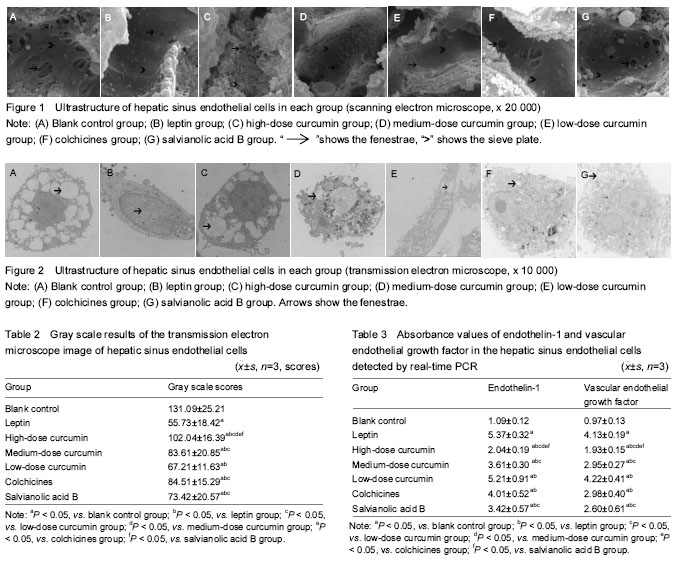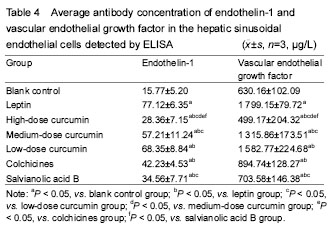中国组织工程研究 ›› 2018, Vol. 22 ›› Issue (8): 1247-1252.doi: 10.3969/j.issn.2095-4344.0144
• 组织构建实验造模 experimental modeling in tissue construction • 上一篇 下一篇
姜黄素抗肝窦毛细血管化作用及机制
段雪琳,彭 岳,赵铁建,韦燕飞,黎桂玉
- 广西中医药大学基础医学院人体机能系,广西壮族自治区南宁市 530200
-
出版日期:2018-03-18发布日期:2018-03-18 -
通讯作者:Zhao Tie-jian, Department of Medical Physiology and Biochemistry, School of Basic Medical Science, Guangxi University of Chinese Medicine, Nanning 530200, Guangxi Zhuang Autonomous Region, China -
作者简介:段雪琳,女,1977年生,汉族,2010年广西中医药大学毕业,硕士,副教授。 并列第一作者:彭岳,男,1981年生,汉族, 2016年成都中医药大学毕业,博士,副教授。 -
基金资助:国家自然科学基金项目(81403189,81460628,81660705,81560690);广西教育厅高教科研项目(YB2014182)
Effect of curcumin against capillarization of hepatic sinusoids and its mechanism
Duan Xue-lin, Peng Yue, Zhao Tie-jian, Wei Yan-fei, Li Gui-yu
- Department of Medical Physiology and Biochemistry, School of Basic Medical Science, Guangxi University of Chinese Medicine, Nanning 530200, Guangxi Zhuang Autonomous Region, China
-
Online:2018-03-18Published:2018-03-18 -
Contact:赵铁建。广西中医药大学基础医学院人体机能系,广西壮族自治区南宁市 530200 -
About author:Duan Xue-lin, Master, Associate professor, Department of Medical Physiology and Biochemistry, School of Basic Medical Science, Guangxi University of Chinese Medicine, Nanning 530200, Guangxi Zhuang Autonomous Region, China Peng Yue, M.D., Associate professor, Department of Medical Physiology and Biochemistry, School of Basic Medical Science, Guangxi University of Chinese Medicine, Nanning 530200, Guangxi Zhuang Autonomous Region, China Duan Xue-lin and Peng Yue contributed equally to this work. -
Supported by:the National Natural Science Foundation of China, No. 81403189, 81460628, 81660705 and 81560690; Scientific Research Project of Universities of Education Department of Guangxi Zhuang Autonomous Region, No. YB2014182
摘要:
.jpg) 文题释义:
肝窦内皮细胞:是构成肝窦最主要的细胞,其具有特有的、密集的窗孔结构,使物质能从血液进入肝实质并在两者间自由交换。肝窦内皮细胞与其他内皮细胞不同,它没有基底膜结构,这些独特的结构使得其在物质交换过程以及肝纤维化形成发展中发挥重要作用。
肝窦毛细血管化:是一种以肝窦内皮细胞窗孔数量减少及连续性基底膜形成,肝内微循环障碍为主要特征的病理过程,其长期发展可导致肝纤维化。
文题释义:
肝窦内皮细胞:是构成肝窦最主要的细胞,其具有特有的、密集的窗孔结构,使物质能从血液进入肝实质并在两者间自由交换。肝窦内皮细胞与其他内皮细胞不同,它没有基底膜结构,这些独特的结构使得其在物质交换过程以及肝纤维化形成发展中发挥重要作用。
肝窦毛细血管化:是一种以肝窦内皮细胞窗孔数量减少及连续性基底膜形成,肝内微循环障碍为主要特征的病理过程,其长期发展可导致肝纤维化。中图分类号:
引用本文
段雪琳,彭 岳,赵铁建,韦燕飞,黎桂玉. 姜黄素抗肝窦毛细血管化作用及机制[J]. 中国组织工程研究, 2018, 22(8): 1247-1252.
Duan Xue-lin, Peng Yue, Zhao Tie-jian, Wei Yan-fei, Li Gui-yu. Effect of curcumin against capillarization of hepatic sinusoids and its mechanism[J]. Chinese Journal of Tissue Engineering Research, 2018, 22(8): 1247-1252.
RT-PCR and EILSA results are shown in Tables 3, 4.


| [1] Ford AJ, Jain G, Rajagopalan P. Designing a fibrotic microenvironment to investigate changes in human liver sinusoidal endothelial cell function. Acta Biomater. 2015;24:220-227.[2] Poynard T, Munteanu M, Deckmyn O, et al. Validation of liver fibrosis biomarker (FibroTest) for assessing liver fibrosis progression: proof of concept and first application in a large population. J Hepatol. 2012;57(3):541-548.[3] Fomin ME, Zhou Y, Beyer AI, et al. Production of factor viii byhuman liver sinusoidal endothelial cells transplanted in immunodeficient uPA mice. PLoS One. 2013;8:e77255.[4] Feng YQ, Yang YS, Cui SL, et al. Advance in the development and application of experimental animal models of liver fibrosis. Guangdong Yaoxueyuan Xuebao. 2013;29(5):1-4.[5] Xie G, Wang X, Wang L, et al. Role of differentiation of liver sinusoidal endothelial cells in progression and regression of hepatic fibrosis in rats. Gastroenterology. 2012;142:918-927.[6] Liang S, Kisseleva T, Brenner DA. The role of NADPH oxidases (NOXs) in liver fibrosis and the activation of myofibroblasts. Front Physiol. 2016;7:17.[7] Connolly BM, Choi EY, Gadsvoll H, et al. Selective abrogation of the uPA-uPAR interaction in vivo reveals a novel role in sup-pression of fibrin-associated inflammation. Blood. 2010;116(9):1593-1603.[8] Du W, San YL, Liao QL, et al. Clinical significances of HA, PⅢNP, LN and CⅣ in the diagnosis of chronic liver disease and liver fibrosis. Chongqing Yike Daxue Xuebao. 2013;10(5):530-533.[9] Wu XL, Wang LK, Xue J, et al. Correlation of expressions of DNA binding differentiation inhibitory proteins-1 and vascular endothelial growth factor with its microvascular generation. Zhongguo Linhcunag Yaolixue Zazhi. 2016;05:430-436.[10] Yin F, Wang S, Hao Y, et al. Progress in pharmacology and mechanism research of curcumin. Hebei Lianhe Daxue Xuebao. 2013;15(11):798-802.[11] Wang XX, Liu WD. Progress in pharmacology research of curcumin. Beifang Yaoxue. 2010;7(2):30-34.[12] Wu SH, Wang YS. Progress of curcumin. Shuli Yiyaoxue Zazhi. 2013;9(3):122-125.[13] Huang MF, Liu DY, Xu R. Action mechanism of curcumin appreciated and analysis on clinical application. Zhonghua Zhongyiyao Xuekan. 2014;11(8):86-92.[14] Peng Y, Miao WN, Zhao TJ, et al. The research on toxicity and its mechanism of human hepatic stellate cells by Plumbagin. Shizhen Guoyi Guoyao. 2016;1(27):5-8. [15] Wei YF, Liu XM, Tang AC, et al. Effects of plumbagozeylanica (plumbago) on expression of transforming growth factorbeta1 in human hepatic stellate cells activated by lepti. Zhongguo Yaolixue Tongbao. 2010;26(6):421-424.[16] Xue DY, Hong JH, Xu LM. Effects of salvianol ic acid B on signal transduction induced by transforming growth factor-BB and plateletderived growth factor-β1 in hepatic stellate cells of rats. Zhongxiyi Jiehe Zazhi. 2006;26(5):439-442.[17] Zhang AL, Yang Z, Xiao XM, et al. Expression of p-moesin in sinusoidal endothelial cell of schistosomal hepatic fibrosis mice. Weixunhuanxue Zazhi. 2012;3:1-8.[18] Mormone E, George J, Nieto N. Molecular pathogenesis of hepatic fibrosis and current therapeutic approaches. Chem Biol Interact. 2011;19(3):225-231.[19] Yang ZX, Han DW, Xing HY, et al. Pathogenesis of hepatic sinusoidal capillarization in hepatic cirrhosis. World J Digestol. 2009;17(30):3101-3108.[20] Huebert Robert C, Shah Vijay H. sinusoidal endothelial cells direct traffic at the intersection of regeneration andfibrosis. Hepatology. 2014;60(2):754-756.[21] Jacobs F, Wisse E, De Geest B. The role of liver sinusoidal cells in hepatocyte-directed gene transfer. Am J Pathol. 2010;176(1):14-21.[22] Tian BF. Progress in the clinical application of colchicines. Kunming Yike Daxue Xuebao. 2009;30(2B):107-111. [23] Xu CS, Zhang H, Ca DH. Advances in clinical application of colchicine. Zhongguo Linchuang Yaoxue Zazhi. 2001;10(3):202.[24] Rambaldi A, Gluud C. Colchicine for alcoholic and non-alcoholic liver fibrosis and cirrhosis. Cochrane Database Syst Rev. 2005;18(2):CD002148.[25] Qu GW, Xie FX, Xue XD, et al. The distribution of salvianolic acid B and tanshinone Ⅱ A in Salvia Miltiorrhiza Bge. Zhongugo Xiandai Yiyao. 2005;7(1):11-13.[26] Zhu YQ, Zong W, Guo XY, et al. Sixty-three cases of fibrosis in patients with chronic hepatitis B treated with telbivudine compared with salvianolate. Shaanxi Yixue Zazhi. 2012;41(7):873-875.[27] Zhu YQ, Yang JS, Zong W, et al. Treatment of 61 cases of hepatitis B cirrhosis with Salvia miltiorrhiza citrate. Shaanxi Zhongyi. 2012;33(5):515-517.[28] Xu XY, Chen J, Hou XH, et al. Antioxidant effects of salvianolic acid B on pancreatic fibrosis. Zhonghua Xiaohua Zazhi. 2007;27(6):409-410.[29] Luo TS, Li HW, Liu ZW, et al. Advances in studies on extraction, separation, and pharmacological action of curcumin. Xiandai Yaowu yu Linchuang. 2011;26(2):102-107.[30] Di JB, Gu ZL, Zhao XD, et al. Advances in studies on antioxidant and anti-inflammation of curcumin. Zhongcaoyao. 2014;5(4):134-138.[31] Zhao ZD. Experimental study on curcuminon anti-liver fibrosis and its mechanism. Zhongguo Shiyan Fangjixue Zazhi. 2010;16(3):122-125.[32] Zhong Y, Zhong XH, Sun YM, et al. Protective effect of curcumin on liver fibrosis induced by carbon tetrachloride in rats. Zhongguo Gonggong Weisheng. 2015;31(4):447-449.[33] Liu XM, Li GY, Deng Y, et al. The effects of Guangxi Curcuma extract to the function of secretory collagen protein and MMPs of human hepatic stellate cell. Shizhen Guoyi Guoyao. 2013;34(4):35-39.[34] Maslak E, Gregorius A, Chlopicki S. Liver sinusoidal endothelial cells (LSECs) function and NAFLD; NO-based therapy targeted to the liver. Pharmacol Rep. 2015;67(4):689-694.[35] Rowe IA, Galsinh SK, Wilson GK, et al. Paracrine signals from liver sinusoidal endothelium regulate hepatitis C virus replication. Hepatology. 2014;59(2):375-384. [36] Li JM, Yan J, Lu WL, et al. Mechanism of liver sinusoidal endothelial cells involved in liver fibrosis. Dalian Yike Daxue Xuebao. 2013;35(1):81-82. [37] Shafiei MS, Lui S, Rockey DC. Integrin-linked kinase regulates endothelial cell nitric oxide synthase expression in hepatic sinusoidal endothelial cells. Liver Int. 2015;35(4):1213-1221.[38] DeLeve LD. Liver sinusoidal endothelial cells in hepatic fibrosis. Hepatology. 2015;61(5):1740-1746.[39] Yang WJ, Lei ZS, Li DY. Effects of nitric oxide and endouthelin-1 on hepatic damage induced by endotoxin in rats. Gandan Waike Zazhi. 2002;10(1):68-70.[40] Zhang J, Zhang ZT, Wang Y, et al. Effect of endothelin-1 and its antagonists on the expression of endothelin receptors mRNA in HSC-T6 cells. Zhonghua Waike Zazhi. 2005;43(21):68-70.[41] Arriazu E, de Galarreta MR, Cubero FJ, et al. Extracellular matrix and liver disease. Antioxid Redox Signal. 2014;21(7):1078-1097.[42] Li XH, Yang PF, Qi HX, et al. The changes and significance of serum TGF-β1, VEGF in patients with chronic hepatitis B, liver fibrosis and liver cirrhosis. Linchuang Xueyaobing Zazhi. 2011;23(3):144-145.[43] Tang X, Yang J, Li J. Sensitization of human hepatic stellate cells to tumor necrosis factorrelated apoptosis-inducing ligand-induced apoptosis by leflunomide. Biol Pharm Bul. 2009;32(6):963-967.[44] Teratani T, Tomita K, Suzuki T, et al. A high-cholesterol diet exacerbates liver fibrosis in micevia accumulation of free cholesterol in hepatic stellate cells. Gastroenterology. 2012;142(1):152-164.[45] Li L, Wang JY, Yang CQ, et al. Effect of RhoA on transforming growth factor β1-induced rat hepatic stellate cell migration. Liver Int. 2012;32(7):1093-1102.[46] Liu J. Chitosan nanoparticles enfolding antisense endothelin converting enzyme RNA expression plasmid and airway hyperresponsiveness in asthmatic mouse models. Zhongguo Zazhi Gongcheng Yanjiu. 2015;19(43):6913-6917. |
| [1] | 张同同, 王中华, 文 杰, 宋玉鑫, 刘 林. 3D打印模型在颈椎肿瘤手术切除与重建中的应用[J]. 中国组织工程研究, 2021, 25(9): 1335-1339. |
| [2] | 侯婧瑛, 于萌蕾, 郭天柱, 龙会宝, 吴 浩. 缺氧预处理激活HIF-1α/MALAT1/VEGFA通路促进骨髓间充质干细胞生存和血管再生[J]. 中国组织工程研究, 2021, 25(7): 985-990. |
| [3] | 曾燕华, 郝延磊. 许旺细胞体外培养及纯化的系统性综述[J]. 中国组织工程研究, 2021, 25(7): 1135-1141. |
| [4] | 徐东紫, 张 婷, 欧阳昭连. 心脏组织工程领域全球专利竞争态势分析[J]. 中国组织工程研究, 2021, 25(5): 807-812. |
| [5] | 吴子健, 胡昭端, 谢有琼, 王 峰, 李 佳, 李柏村, 蔡国伟, 彭 锐. 3D打印技术与骨组织工程研究文献计量及研究热点可视化分析[J]. 中国组织工程研究, 2021, 25(4): 564-569. |
| [6] | 常文辽, 赵 杰, 孙晓亮, 王 锟, 吴国锋, 周 剑, 李树祥, 孙 晗. 人工骨膜的材料选择、理论设计及生物仿生功能[J]. 中国组织工程研究, 2021, 25(4): 600-606. |
| [7] | 刘 旒, 周箐竹, 龚 桌, 刘博言, 杨 斌, 赵 娴. 胶原/无机材料构建组织工程骨的特点及制造技术[J]. 中国组织工程研究, 2021, 25(4): 607-613. |
| [8] | 刘 飞, 崔宇韬, 刘 贺. 局部抗生素递送系统治疗骨髓炎的优势与问题[J]. 中国组织工程研究, 2021, 25(4): 614-620. |
| [9] | 李晓壮, 段 浩, 王伟舟, 唐志宏, 王旸昊, 何 飞. 骨组织工程材料治疗骨缺损疾病在体内实验中的应用[J]. 中国组织工程研究, 2021, 25(4): 626-631. |
| [10] | 张振坤, 李 喆, 李 亚, 王莹莹, 王亚苹, 周馨魁, 马珊珊, 关方霞. 海藻酸盐基水凝胶/敷料在创面愈合中的应用:持续、动态与顺序释放[J]. 中国组织工程研究, 2021, 25(4): 638-643. |
| [11] | 陈佳娜, 邱燕玲, 聂敏海, 刘旭倩. 组织工程支架材料修复口腔颌面部软组织缺损[J]. 中国组织工程研究, 2021, 25(4): 644-650. |
| [12] | 邢 浩, 张永红, 王 栋. 长骨大段骨缺损修复方法的优势与不足[J]. 中国组织工程研究, 2021, 25(3): 426-430. |
| [13] | 王 皓, 陈明学, 李俊康, 罗旭江, 彭礼庆, 李 获, 黄 波, 田广招, 刘舒云, 眭 翔, 黄靖香, 郭全义, 鲁晓波. 脱细胞猪皮基质构建组织工程半月板支架[J]. 中国组织工程研究, 2021, 25(22): 3473-3478. |
| [14] | 莫剑玲, 何少茹, 冯博文, 简敏桥, 张晓晖, 刘财盛, 梁一晶, 刘玉梅, 陈 亮, 周海榆, 刘艳辉. 构建预血管化细胞膜片及血管形成相关因子的表达[J]. 中国组织工程研究, 2021, 25(22): 3479-3486. |
| [15] | 刘 畅, 李大同, 刘 元, 孔令擘, 郭 瑞, 杨利学, 郝定均, 贺宝荣. 急性症状性骨质疏松性胸腰椎压缩骨折椎体强化手术后疗效欠佳:与骨水泥、骨密度、邻近骨折的关系[J]. 中国组织工程研究, 2021, 25(22): 3510-3516. |
中国组织工程研究杂志出版内容重点:组织构建;骨细胞;软骨细胞;细胞培养;成纤维细胞;血管内皮细胞;骨质疏松;组织工程
|
Table 1 Gene sequences
|
|
|
Note: VEGF: vascular endothelial growth factor.
|
Statistical analysis was performed using PEMS 3.1 software. Data are expressed as the mean±SD. Measurement data between groups were compared using one-way analysis of variance and chi-squaretest. P < 0.05 was considered statistically significant.
中国组织工程研究杂志出版内容重点:组织构建;骨细胞;软骨细胞;细胞培养;成纤维细胞;血管内皮细胞;骨质疏松;组织工程
中国组织工程研究杂志出版内容重点:组织构建;骨细胞;软骨细胞;细胞培养;成纤维细胞;血管内皮细胞;骨质疏松;组织工程
文章快速阅读:
.jpg) 文题释义:
肝窦内皮细胞:是构成肝窦最主要的细胞,其具有特有的、密集的窗孔结构,使物质能从血液进入肝实质并在两者间自由交换。肝窦内皮细胞与其他内皮细胞不同,它没有基底膜结构,这些独特的结构使得其在物质交换过程以及肝纤维化形成发展中发挥重要作用。
肝窦毛细血管化:是一种以肝窦内皮细胞窗孔数量减少及连续性基底膜形成,肝内微循环障碍为主要特征的病理过程,其长期发展可导致肝纤维化。
中国组织工程研究杂志出版内容重点:组织构建;骨细胞;软骨细胞;细胞培养;成纤维细胞;血管内皮细胞;骨质疏松;组织工程
文题释义:
肝窦内皮细胞:是构成肝窦最主要的细胞,其具有特有的、密集的窗孔结构,使物质能从血液进入肝实质并在两者间自由交换。肝窦内皮细胞与其他内皮细胞不同,它没有基底膜结构,这些独特的结构使得其在物质交换过程以及肝纤维化形成发展中发挥重要作用。
肝窦毛细血管化:是一种以肝窦内皮细胞窗孔数量减少及连续性基底膜形成,肝内微循环障碍为主要特征的病理过程,其长期发展可导致肝纤维化。
中国组织工程研究杂志出版内容重点:组织构建;骨细胞;软骨细胞;细胞培养;成纤维细胞;血管内皮细胞;骨质疏松;组织工程
实验从肝窦内皮细胞形态及分泌功能的视角,研究姜黄素对肝纤维化干预作用的分子机制,为中医药治疗肝纤维化提供了新思路和新靶点,为开发和利用盛产于广西的姜黄科植物治疗肝纤维化提供出更多的科学依据。 中国组织工程研究杂志出版内容重点:组织构建;骨细胞;软骨细胞;细胞培养;成纤维细胞;血管内皮细胞;骨质疏松;组织工程
| 阅读次数 | ||||||
|
全文 |
|
|||||
|
摘要 |
|
|||||